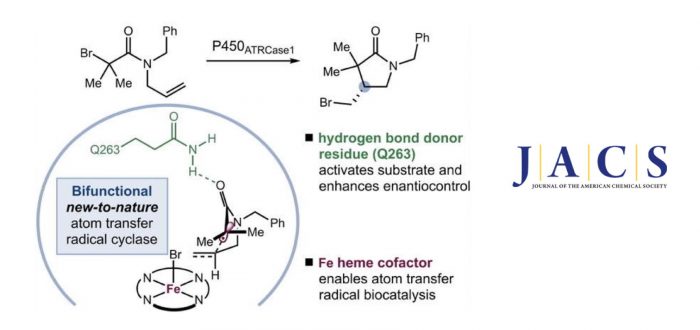New-to-nature radical biocatalysis has recently emerged as a powerful strategy to tame fleeting open-shell intermediates for stereoselective transformations. In 2021, it was introduced a novel metalloredox biocatalysis strategy that leverages the innate redox properties of the heme cofactor of P450 enzymes, furnishing new-to-nature atom-transfer radical cyclases (ATRCases) with excellent activity and stereoselectivity. Herein, it is reported a combined computational and experimental study to shed light on the mechanism and origins of enantioselectivity for this system. Molecular dynamics and quantum mechanics/molecular mechanics (QM/MM) calculations revealed an unexpected role of the key beneficial mutation I263Q. The glutamine residue serves as an essential hydrogen bond donor that engages with the carbonyl moiety of the substrate to promote bromine atom abstraction and enhance the enantioselectivity of radical cyclization. Therefore, the evolved ATRCase is a bifunctional biocatalyst, wherein the heme cofactor enables atom-transfer radical biocatalysis, while the hydrogen bond donor residue further enhances the activity and enantioselectivity. Unlike many enzymatic stereocontrol rationales based on a rigid substrate binding model, our computations demonstrate a high degree of rotational flexibility of the allyl moiety in an enzyme–substrate complex and succeeding intermediates. Therefore, the enantioselectivity is controlled by the radical cyclization transition states rather than the substrate orientation in ground-state complexes in the preceding steps. During radical cyclization, anchoring effects of the Q263 residue and steric interactions with the heme cofactor concurrently control the ?-facial selectivity, allowing for highly enantioselective C–C bond formation. The computational findings are corroborated by experiments with ATRCase mutants generated from site-directed mutagenesis.
This project is a collaboration between the IQCC research team led by Dr. Marc Garcia-Borràs and the experimental group of Ass. Prof. Yang Yang (UCSB) and the computational group of Prof. Peng Liu (U Pittsburgh). The project has been carried out in the framework of the research program that Dr. Garcia-Borràs leads at the IQCC, which is devoted to the use of computational methods in combination with experiments to characterize and design new abiological enzymatic activities and synthetically useful biocatalysts on “Biocatalytic intermediates for the discovery and design of new enzymatic activities”.
These results have recently been published in the Journal of the American Chemical Society:
Y. Fu, H. Chen, W. Fu, M. Garcia-Borràs, Y. Yang and P. Liu
“Engineered P450 Atom-Transfer Radical Cyclases are Bifunctional Biocatalysts: Reaction Mechanism and Origin of Enantioselectivity”
J. Am. Chem. Soc. 2022, ASAP
DOI: 10.1021/jacs.2c04937
Girona, July 15, 2022
For more info: gestor.iqcc@gmail.com

